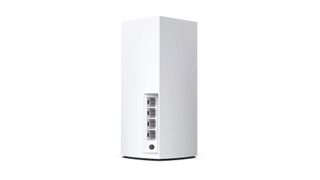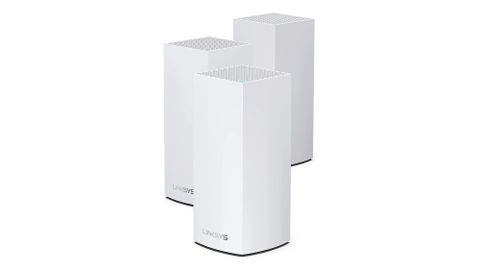IT Pro Verdict
Pros
- +
Outstanding speeds and range
- +
Generous quantity of Gigabit Ethernet ports
- +
Affordable pricing
Cons
- -
Web management console is slow and clunky
If you’re thinking you’ve seen these miniature towers somewhere before, you’re right: despite the new name, Linksys’ latest Wi-Fi 6 mesh is an evolution of its long-established Velop system.
Unlike the original Velop, the Atlas Pro 6 is a dual-band design, operating a traditional 2.4GHz wireless network plus a faster 5GHz network. As there’s no third radio, the 5GHz channel ferries both backhaul and client data back and forth, a compromise that helps keep the price down.
The units are tastefully designed, with square tops that gently round out towards the base. They’re dinkier than you might expect, standing 185mm tall with an 85 x 85mm footprint, but they have quite some range: Linksys claims the three-unit set can cover an area of up to 750m2, which is far larger than the average UK home. For three rooms or fewer you can make do with a twin-pack, which also saves a handy chunk of cash. You can also connect a decent number of wired clients – you’ll find four Gigabit Ethernet ports stacked up at the back of each unit.
Setup is handled by the Linksys mobile app, which detected our first node almost instantly and guided us through picking our network name and security settings. Once your Atlas system is running, you can use the app to check on connected clients and carry out basic management tasks, such as configuring port forwarding and nominating up to three high-priority devices – handy for home working. Parental controls are offered too, though these are minimal: if you want to block unsavoury websites, you have to enter each one’s URL by hand.
If you prefer not to be tied to an app, you can manage the Atlas Pro 6 from a desktop browser; in fact, this is the only way to access a few options, such as giving different names to the 2.4GHz and 5GHz networks. However, Linksys’ ageing Smart Wi-Fi console is slow and fiddly, and is laid out completely differently to the app. And no matter which interface you use, there’s no support for VPNs, nor any security functions.

We’ve already noted that dual-band meshes require the 5GHz radio to do double duty, and this inescapably reduces the effective bandwidth of the system. To its credit, Linksys has done what it can to keep things moving swiftly. The Atlas Pro 6’s 5GHz radio is as fast as you’ll find on any domestic router, using the maximum 160MHz channel width and supporting transfer speeds of up to 4.8Gbits/sec with 4x4 MU-MIMO. The system also uses the latest Qualcomm 216 wireless chipset; the import of that might not be immediately obvious, but – as we’ve seen with the TP-Link Deco X90 – the newest Wi-Fi 6 chips deliver a striking uplift in wireless performance compared to the previous generation.
To see how all this translates to real-world performance, we set up the three Atlas Pro 6 stations in our test premises, situating the nodes throughout the building. We connected an Asustor NAS appliance to the main Atlas station via Gigabit Ethernet, and used a laptop to copy a set of 100MB files to and from the NAS from various parts of the building, measuring upload and download speeds over the 5GHz network.
The results were very creditable. Predictably, the Atlas Pro 6 didn’t match the headline speeds of pricier tri-band systems, but it gave us a strong download speed of 60.2MB/sec at short range. That’s just over 480Mbits/sec, well beyond the full speed of a typical domestic internet connection; for context, 25Mbits/sec should be sufficient for 4K HDR streaming.
We were just as pleased by the performance we saw in other rooms. With older meshes we’ve sometimes seen a big drop-off in speed away from the primary unit, as the connection switches to one of the extender nodes. But even in the hard-to-reach area at the back of the building, the Atlas Pro 6 kept up a solid 44MB/sec – enough bandwidth for a rock-solid online experience, whether you’re gaming, streaming or working from home.
What’s particularly striking about the Atlas Pro 6 is that it performs better than many tri-band systems. That includes our former top pick, the Netgear Orbi RBK752: while upload speeds were similar across the two systems, the Atlas Pro 6 provided faster downloads in every test.
Let’s not get carried away. The Atlas Pro 6 couldn’t keep up with the TP-Link Deco X90 anywhere in our test location, its software isn’t as slick and it also lacks the Deco’s multi-gig Ethernet support. However, the Atlas is more than fast enough to race through typical networking tasks, and the versatile three-node package gives you the freedom to extend coverage where you need it. For most small premises, there’s little sense in spending more.
Linksys Atlas Pro 6 specifications
| Band support | Dual-band 2.4GHz/5GHz Wi-Fi 6 |
| Radios | 5 x internal MU-MIMO antennas (per unit) |
| Ports | 4 x GbE (per unit) |
| Dimensions (WDH) | 86 x 86 x 185mm (WDH) |
| Weight | 454g (per unit) |
Darien began his IT career in the 1990s as a systems engineer, later becoming an IT project manager. His formative experiences included upgrading a major multinational from token-ring networking to Ethernet, and migrating a travelling sales force from Windows 3.1 to Windows 95.
He subsequently spent some years acting as a one-man IT department for a small publishing company, before moving into journalism himself. He is now a regular contributor to IT Pro, specialising in networking and security, and serves as associate editor of PC Pro magazine with particular responsibility for business reviews and features.
You can email Darien at darien@pcpro.co.uk, or follow him on Twitter at @dariengs.



